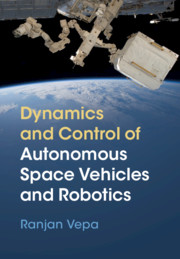Book contents
- Dynamics and Control of Autonomous Space Vehicles and Robotics
- Dynamics and Control of Autonomous Space Vehicles and Robotics
- Copyright page
- Dedication
- Contents
- Preface
- Acronyms
- 1 Introduction to Autonomous Space Vehicles and Robotics
- 2 Space Vehicle Orbit Dynamics
- 3 Space Vehicle Attitude Dynamics and Control
- 4 Manipulators on Space Platforms
- 5 Kinematics, Dynamics, and Control of Mobile Robot Manipulators
- 6 Planetary Rovers and Mobile Robotics
- 7 Navigation and Localization
- 8 Sensing and Estimation of Spacecraft Dynamics
- Index
- References
5 - Kinematics, Dynamics, and Control of Mobile Robot Manipulators
Published online by Cambridge University Press: 29 April 2019
- Dynamics and Control of Autonomous Space Vehicles and Robotics
- Dynamics and Control of Autonomous Space Vehicles and Robotics
- Copyright page
- Dedication
- Contents
- Preface
- Acronyms
- 1 Introduction to Autonomous Space Vehicles and Robotics
- 2 Space Vehicle Orbit Dynamics
- 3 Space Vehicle Attitude Dynamics and Control
- 4 Manipulators on Space Platforms
- 5 Kinematics, Dynamics, and Control of Mobile Robot Manipulators
- 6 Planetary Rovers and Mobile Robotics
- 7 Navigation and Localization
- 8 Sensing and Estimation of Spacecraft Dynamics
- Index
- References
- Type
- Chapter
- Information
- Dynamics and Control of Autonomous Space Vehicles and Robotics , pp. 206 - 228Publisher: Cambridge University PressPrint publication year: 2019
References
- 1
- Cited by



